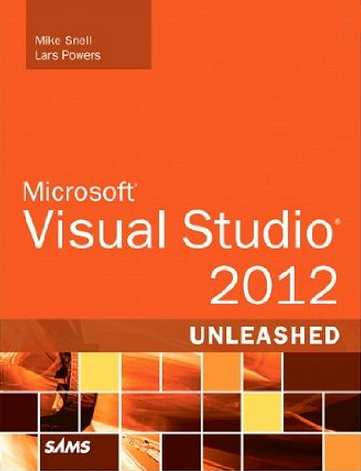| Microsoft Visual Studio 2012 Unleashed |
Author: Mike Snell and Lars Powers
If you strip out of this book all of the chapters that are about other connected but peripheral topics then there isn't much of the book left. This isn't so much Visual Studio Unleashed, more a sort of look at all the other pooches in the same park and a slight loosening of the collar.
The book is divided into five large sections. The first is an introduction to Visual Studio - very basic. The second is an in depth look at the IDE - which despite being "in depth" is still very basic. There are lots of screen dumps showing you the obvious and to be honest if you need this level of introduction to Visual Studio then you probably aren't going to survive as a programmer. Part III is about writing and working with code - productivity aids, testing code, refactoring, debugging and deploying. This part is slightly more interesting with details of how things can be done that you might otherwise miss. Part IV is about Extending Visual Studio - the object model, macros, add-ins and Wizards and the most up-to-date approach and the .NET way to extend Visual Studio - the MEF. Finally we have a long (400 page) section on creating enterprise applications. This is about ASP .NET, forms, MVC, Razor, databases, services and so on .. what it isn't about is Visual Studio. New in this edition of the book is a look at developing for Azure and WinRT. Developing for WinRT would be better covered in a book on Visual Studio 2013. As it is the chapters are so short as not to be particularly helpful. You could try to justify the inclusion of this final section on different types of application development on the grounds that it shows you how to use the specific explorers, e.g. in database there is the server explorer - but these are topics that would be well covered in a book on .NET SQL development. Given that they are in a book about Visual Studio the subjects aren't covered in much depth and it is difficult to see who exactly is going to be reading them to find out how to get started. Of course you might disagree and regard this final very large section as just what you were looking for. Without this section the book is one third of the size.
As for me, the most interesting part of the book are the chapters on extending Visual Studio, but even here it doesn't really get to grips with its subject. There are far too many tables of standard information and other space fillers. When we do get to an example the listings are long and largely unexplained. For most readers this and the section before it on debugging and so on are likely to be the most helpful. You might find this book useful - I didn't. To sum up - too much of the book is off-topic and what is on topic isn't particularly deep or explained. I'd give this one a miss.
|
|||
| Last Updated ( Thursday, 08 August 2013 ) |


